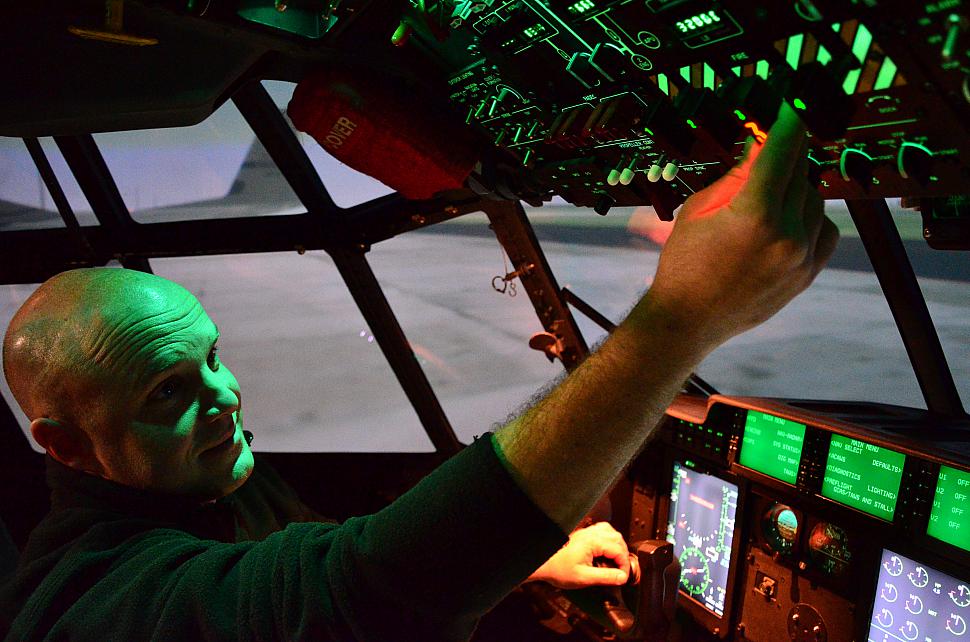C-130 News
C-130 Hercules News
Keesler maintainers hone C-130 fire drill skills
February 17, 2015 (by
MSgt. Brian lamar) -
The C-130J cockpit fills with alarms and blinking lights as Tech. Sgt. Ronnie Graham, a turboprop craftsman with the 403rd Maintenance Squadron's Propulsion Flight, methodically runs through his mental checklist to suppress and extinguish a fire in the engine three compartment.

Luckily for Graham, this fire is only a scenario in the Keesler Air Force Base C-130J simulator during annual refresher training for maintenance members to recertify themselves to be qualified to start an aircraft.
"Most people do not realize that we are required to train in a cockpit of a simulator, and we are actually responsible for the entire aircraft on the ground," said Graham.
The three-day refresher course in the C-130J simulator is designed to re-familiarize maintenance personnel with the appropriate procedures for any scenario they may encounter such as engine fires, startup malfunctions, hydrologic and electrical system malfunctions and regaining control over the aircraft if it begins moving spontaneously.
"One of the advantages to the simulator is that we can throw all kinds of malfunctions and emergency situations at them that they have to respond to in the simulator, but hope they don't have experience on the real airplane," said Bynon. "During an in-plane refresher on a real airplane, it would most likely just be a regular engine run scenario that they do everyday, but it is not as educational as making the plane start to move and watch the guys manage to safely control it." He added.
Each year, the simulator instructor staff trains 120 maintainers with 60 two-person classes in this course.
The refresher training isn't required to be completed inside a simulator, said Bynon. It can be done in a C-130J.
"The course is unique and important," said Chris Marcelli, the site director for the Keesler C-130J aircraft simulator. "Normally, maintainers don't get trained how to control the airplane, because they don't move it [without a tow truck], but there is a small chance that the airplane will jump the chocks and start rolling. They need to be trained how to bring the plane to a stop safely. It is not just like jamming on the brakes in a car. There is a procedure that needs to be learned."
Fortunately for the maintainers of the 403rd, incidents like the ones they train for rarely occur, but they value the training in the event they need to know what to do quickly.
"This training helps me run through some scenarios that I will hopefully never encounter. It is also a great opportunity to get instructor feedback as well," said Graham.
TSgt. Ronnie Graham, a turboprop craftsman with the 403rd AMXS, goes through his checklist to suppress and extinguish a fire during a fire drill in the 403rd C-103J simulator on January 6. Graham is one of 120 maintainer students who endure the annual maintenance engine run refresher course each year. [USAF photo by MSgt. Brian Lamar]
"Most people do not realize that we are required to train in a cockpit of a simulator, and we are actually responsible for the entire aircraft on the ground," said Graham.
The three-day refresher course in the C-130J simulator is designed to re-familiarize maintenance personnel with the appropriate procedures for any scenario they may encounter such as engine fires, startup malfunctions, hydrologic and electrical system malfunctions and regaining control over the aircraft if it begins moving spontaneously.
"One of the advantages to the simulator is that we can throw all kinds of malfunctions and emergency situations at them that they have to respond to in the simulator, but hope they don't have experience on the real airplane," said Bynon. "During an in-plane refresher on a real airplane, it would most likely just be a regular engine run scenario that they do everyday, but it is not as educational as making the plane start to move and watch the guys manage to safely control it." He added.
Each year, the simulator instructor staff trains 120 maintainers with 60 two-person classes in this course.
The refresher training isn't required to be completed inside a simulator, said Bynon. It can be done in a C-130J.
"The course is unique and important," said Chris Marcelli, the site director for the Keesler C-130J aircraft simulator. "Normally, maintainers don't get trained how to control the airplane, because they don't move it [without a tow truck], but there is a small chance that the airplane will jump the chocks and start rolling. They need to be trained how to bring the plane to a stop safely. It is not just like jamming on the brakes in a car. There is a procedure that needs to be learned."
Fortunately for the maintainers of the 403rd, incidents like the ones they train for rarely occur, but they value the training in the event they need to know what to do quickly.
"This training helps me run through some scenarios that I will hopefully never encounter. It is also a great opportunity to get instructor feedback as well," said Graham.
Courtesy of 403rd Wing Public Affairs
Related articles:
Forum discussion:
Tags
- Dyess receives first-of-its kind $26 million C-130J simulator (2014-04-23)
- C-130 Fighting Falcon news archive
Forum discussion:
- Start a discussion about this article in the C-130.net forum.
Tags
